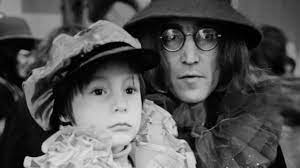White Feather (1968)
“Na, na, na, na na na na na na na na, Hey Jude…” Generations of Beatles’ fans rock to the lyric although many might be mystified as to the identity of Jude. The allusion refers to Julian Lennon; the reason for the name change—Paul McCartney felt “it sounded better.”
A remarkable distinction would be to have inspired one of the greatest songs of the twentieth century; Julian inspired two. The dual muse was born in Liverpool, England, in 1963, to John and Cynthia Lennon. His parents christened him Julian after his paternal grandmother, Julia. He went by the nickname Jules.
A popular belief regarding the 1967 song, “Lucy in the Sky with Diamonds,” is the title refers to LSD. Insistent it was not an “acid song,” John stated, “I swear to God, or swear to Mao, or to anybody, I had no idea it spelt LSD.” The public’s response, “Yeah, right.” 
At age four, Julian was at Heath House, his Surrey preschool, where he drew a watercolor of classmate Lucy O’Donnell. As he showed his picture with its backdrop of exploding stars to his father, he explained it was of his friend, Lucy. At the time, John was working on the album Sgt. Pepper’s Lonely Hearts Club Band, and he transformed the painting into psychedelic images of “newspaper taxis” and “a girl with kaleidoscope eyes.” The world’s most famous human ancestor, the 3.2-million-year-old Lucy, received her name after the Beatles’ song.
The childhood friends reconnected in 2009 after Julian discovered that Lucy, (after marriage, Lucy Vodden), was in a fight for her life against lupus. From his home in France, Julian sent Lucy a garden center gift voucher as she found solace in plants. The accidental muse claimed she enjoyed her connection to “Lucy in the Sky with Diamonds” though admitted she was not fond of the actual song. Lucy passed away from lupus in 2009.
The following year, John delivered a “Hello. Goodbye,” to his wife and son after Cynthia had returned from a vacation and discovered John and Yoko dressed in matching white bathrobes, one of which was hers. Her husband said “hello;” Yoko did not utter a word. Paul McCartney, (who Julian called Uncle Paul), drove his Aston Martin from London to Surrey to spend time with the boy with whom he shared a close relationship. On his way to the Lennon house, the words, “Hey, Jules, don’t make it bad, take a sad song and make it better…” wafted into his mind. John—whose narcissism was in equal proportion to his musical brilliance—assumed he was the song’s Jude. Elvis Presley, Ella Fitzgerald, Diana Ross, and Smokey Robinson all recorded the classic hit. Julian’s take on “Hey, Jude,” “It’s a song I love to hear and hate to hear at the same time.”
The divorce left Julian with resentment against his father who was deeply committed in raising his half-brother, Sean. The bitterness became apparent when Julian recalled how his dad had said that his first-born had been the result of a whiskey bottle on a Saturday night while Sean had been planned. He railed that John was a hypocrite who espoused love and yet had abandoned his wife and first-born. Yet, there were good times, even after John moved to New York. For Julian’s 17th birthday, the legendary singer threw his son a party on a yacht near his Palm Beach mansion. The occasion was the last time they saw one another. Eight months later, John David Chapman assassinated John Lennon when the Beatle was signing an autograph outside his Manhattan home in the Dakota Hotel. The event devastated Julian who recalled what John had once told him, “If something ever happens to me, the way that you will know that everything’s going to be all right will be in the form of a white feather.” The name of Julian’s charitable foundation: White Feather.


